

It's Fall Rally Time!
The Mount Rogers Fall Naturalist Rally is almost here and we are excited to explore, discover and share!

Fall Rally Re-Cap!
We were so excited to host the first ever Mount Rogers Fall Naturalist Rally this October!

Rally, Rally, Rally!
The rally is quickly approaching and we are so excited to share some of the program lineup!

Mt. Roger's Fall Naturalist Rally Keynote Speaker: Michael St. Germain
Read about Michael St. Germain and the bat species found in Virginia!

Signs of Fall Abound
Our weather is showing some cool night time temperatures, but frost is still 2-3 weeks away and there is lots of insect activity and still some late bird migration underway. Fall fruits are much in evidence, offering immediate snacks and some long term food supply. One of my favorites is the blue fruit of arrow wood viburnum. They are small enough for many species to eat and we have so many plants that they last into the fall. In contract, the winterberry hollies in our marshes are very bright red and seem to be a fruit that is not eaten so early as the viburnums. Isn't it interesting that such different colors are both so attractive to birds?

A September Nature Ramble
As summer draws to a close, there is still a great deal of animal activity and a different group of late blooming flowers. I seem to appreciate the sunrises and sunsets more in part because I am tired of working on the yard and want to sit and enjoy the view!